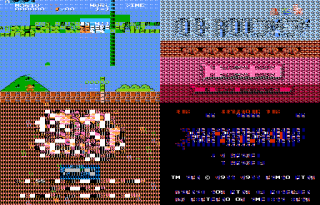Jeremiah Johnson
Data Spills
Based on the slash paintings of Lucio Fontana – "Data Spills" explores the aesthetic transformations that occur when videogame software is cut, spilling its program logic into the representational layer.
http://www.datacorruption.org

Classes
Game Studies,The Nature of Code
Game Studies,The Nature of Code
"Data Spills" was born out of work that I did for my Nature of Code midterm project. I wrote a Processing sketch which sought to recreate the slash paintings of Lucio Fontana in a screen-based medium, rather than on a canvas. The project was successful in its initial goal of allowing a user to create a digital representation of a slash painting. However, I felt that the essence of Fontana's original work was lost in the process of remediation. The translation seemed ignorant of the shift in medium and the physicality of cutting a canvas was lost in the simulation. I began considering the context of the shift in medium and thinking about what it would mean to "cut" a program or piece of software. Code does not tear like a stretched canvas, but it does break in its own visually unique way. Fontana's slash paintings brought the background behind the canvas into the foreground of the work. Software is generally divided into a program logic and the user interface. More specifically, videogames consist of the logic that govern the mechanics, interaction and flow of the game world and the graphics that represent that world to the player. Through a process incremental data manipulation I was able to create ruptures in the representational layer of these games that allowed the program logic to bleed out into the screen space. After researching the way in which data is organized within these videogames, modifications were initially accomplished through manual hex editing of binary files. After establishing the constraints to this approach I developed a Processing application that allowed me to load games into byte arrays and carry out more complex operations on the memory space algorithmically. I believe the result is a remediation which more successfully translates Fontana's work while keeping the conceptual aspects of the original intact.
Implementation
2 x Nintendo Entertainment System consoles running flash memory based game cartridges containing modified videogame software. Consoles are hooked up to 2 x projectors, projecting onto adjacent sections of wallspace. Viewer is given a game controller which is wired up to both consoles, controlling both projections simultaneously.
Conclusion
I learned how tedious hex editing raw binary files can be. I discovered how a 4-color, 8x8 pixel image can be stored in 16 bytes. I broke everything I could get my hands on.
Implementation
2 x Nintendo Entertainment System consoles running flash memory based game cartridges containing modified videogame software. Consoles are hooked up to 2 x projectors, projecting onto adjacent sections of wallspace. Viewer is given a game controller which is wired up to both consoles, controlling both projections simultaneously.
Conclusion
I learned how tedious hex editing raw binary files can be. I discovered how a 4-color, 8x8 pixel image can be stored in 16 bytes. I broke everything I could get my hands on.

